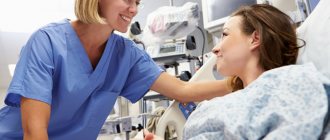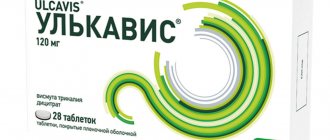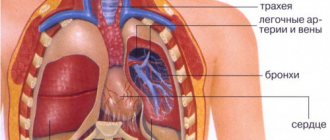Myth 1. Scars disappear on their own.
Scars do not disappear on their own. They need to be treated or corrected. There are many different surgical and conservative techniques for this.
There are several stages of scar formation:
- Stage I - inflammation and epithelization (7-10 days after injury). Post-traumatic inflammation of the skin gradually decreases. The edges of the wound are connected to each other by fragile granulation tissue; there is no scar as such yet. This period is very important for the formation of a thin and elastic scar in the future - it is important to prevent suppuration and divergence of the edges of the wound.
- Stage II - formation of a “young” scar (10-30 days after injury). Collagen and elastin fibers begin to form in the granulation tissue. Increased blood supply to the area of injury remains - the scar is bright pink. During this period, repeated external trauma and excessive physical effort should not be allowed.
- Stage III - formation of a “mature” scar (up to 1 year).
The number of vessels decreases - the scar thickens and becomes pale. Physical activity is allowed to the usual extent. Before 1 year, the final transformation of the scar occurs. Scar tissue slowly matures - blood vessels completely disappear from them, collagen fibers line up along the lines of greatest tension.
If the process of wound healing and scar formation proceeded without complications, then the scar becomes light, elastic and almost invisible, that is, normotrophic. Normotrophic scars do not disappear, but if you follow your doctor’s recommendations for scar care, they usually become almost invisible. Hypertrophic and kelod scars must be treated.
You should know that the formation of scar tissue is characterized by certain stages of development: extensive growth, plateau, spontaneous regression of the scar. The positive effect observed with long-term use of any anti-scar drug may coincide in timing with the natural stage of regression of scar tissue and mislead the specialist and the patient in good faith.
Find out which method of correcting scars and stretch marks is optimal for you!
doctor Svetlana Viktorovna Ogorodnikova.
doctor
Myth 2. You can get rid of a scar only through surgery.
Scars can occur due to various injuries in different circumstances. The choice of the optimal treatment method depends on the characteristics of the scar and is carried out exclusively by the doctor. For example, if a patient has large scars and severe scars, surgical intervention is often required. And if the scar is small and does not limit a person’s physical capabilities, then cosmetic correction can be carried out using conservative techniques.
Factors influencing the choice of scar treatment include:
- patient's age;
- hereditary factor;
- nature of damage;
- localization of damage;
- extent of damage.
As noted above, there are 2 types of scar treatment: conservative and surgical.
Conservative treatment
Conservative methods include:
- Peeling
- Use of creams and ointments
- Silicone preparations
- Using special compression garments
- Physiotherapy
Dermabrasion is a procedure for removing the top layer of skin by grinding with special rotating brushes. As a result, scar tissue is smoothed out. However, such an operation is very traumatic and painful. Some of the capillaries may be removed along with the top layer of skin, and this will lead to bleeding.
Microdermabrasion is the removal of keratinized epidermal cells using aluminum dioxide microcrystals. This procedure is less painful than dermabrasion, since the capillaries in the skin are not affected when exfoliating dead cells. It is mainly used to remove old acne scars.
Anti-scar agents are used to prevent the growth of scar formations at the initial stage of formation, as well as to correct already formed scars.
To achieve the fastest and most obvious results, physiotherapy (phonophoresis, electrophoresis) with anti-scarring agents is used. The procedures can be performed in a clinic or at home.
Self-medication can lead to the opposite result, so before using any remedy you should consult a specialist.
The action of silicone-containing preparations is aimed at normalizing the water balance in the epidermis and reducing the activity of the formation of pathological collagen. Silicone patches and silicone-containing gels also create pressure on the scar, which leads to a slowdown in its growth and an increase in skin elasticity. Silicone-containing products are intended for the prevention and correction of immature scars.
Pressure bandages and underwear are sewn from elastic cotton fabric to order according to individual sizes. Wearing period is at least 6 months. As a rule, compression garments are prescribed for the treatment of keloids and hypertrophic scars. Compression pressure stops the growth of scar tissue by squeezing the vessels that feed it.
Physiotherapy has an anti-inflammatory and analgesic effect, which is associated with the restoration of local microcirculation, leading to the normalization of the processes of collagen and elastin synthesis. This method of drug delivery increases its activity and prolongs its effect, reducing the number of adverse reactions.
Surgical treatment
Surgical methods for treating scars include:
- Surgical excision.
- Laser correction (grinding).
- Skin grafting with the possibility of transplanting areas of the epidermis.
To improve the appearance of some scars, simply removing the scar tissue and re-closing the wound, that is, excision of the old scar, is sufficient. If there is enough skin adjacent to the scar, surgical excision removes scar tissue, then the edges of the skin are carefully sutured. As a result, instead of a scar, a thin, less noticeable scar remains.
Laser removal of scar tissue makes scars less noticeable. The laser beam destroys excess cells on the surface of the scar, giving it a natural appearance. In addition, laser treatment of deeper layers of skin is possible. For laser treatment, local anesthesia is often used; in rare cases, general anesthesia is required. Several procedures are required to achieve the effect. After a course of procedures, a rehabilitation period is required.
Skin grafts are a serious method for scar removal. In this case, the scar is excised, and skin from another (donor) area of the body is used to cover this area. This method is effective for large scar areas; it is often used in the treatment of burn scars. The operation is usually performed using general anesthesia. The transplant leaves small scars on both the donor sites and the transplant area.
Introduction
The problem of treating patients with gastric ulcer remains extremely relevant; many authors note an annually increasing incidence, a high frequency of complicated forms and deaths [9, 20, 21]. The incidence of hard-to-heel gastric ulcers (PGUs) varies from 10 to 23% [2, 3]. They are characterized by a lack of healing against the background of adequate drug therapy [11, 16]. According to B.D. Komarova et al. [11], the following reasons contribute to the prevalence of TG: 1) blind, formulaic prescription of medications without taking into account the secretory, motor, and evacuation functions of the stomach, i.e. without proper examination; 2) exposure to adverse factors of general (diet, smoking, alcohol) and local (degenerative, destructive changes in the gastric mucosa) significance.
Repeated ineffective conservative treatment of TJ leads to the fact that 8-20% of patients arrive late at the surgical clinic with already developed complications [4, 19]. A number of authors believe that surgery should precede the occurrence of complications of gastric ulcer; in such cases, the surgeon often retains the opportunity to perform adequate correction of anatomical and functional changes in the gastroduodenal complex using organ-preserving technologies [6, 7, 12, 17]. The development and introduction into surgical practice of organ-preserving, reconstructive, restoring and correcting the main functions of the gastroduodenal complex of operations for gastric ulcers made it possible to substantiate and expand the indications for their implementation.
The purpose of the study is to clarify the indications for elective surgical treatment of varicose veins using organ-sparing operations based on identifying morphological and functional predictors of ineffectiveness of drug therapy.
Material and methods
In the period from 2002 to 2007, 454 patients with gastric ulcer were examined at the Russian Center for Functional Surgical Gastroenterology. The age of the patients was from 35 to 72 years (mean age 53.4±14.7 years), the ratio of men to women was 1:1.3. Prospectively, based on the results of morphological and functional studies of the condition of the upper digestive tract and treatment, two groups were identified: 1st - 104 patients with severe gastritis who underwent gastroplasty according to V.I. Onopriev; 2nd - 350 patients with a positive result of conservative treatment. The control group consisted of 20 healthy volunteers (their examination data was used to establish standard indicators of periodic motor activity of the gastroduodenal complex).
Technology of gastroplasty according to V.I. Onopriev included segmental removal of the body of the stomach with an ulcer, preservation of the innervated pyloroantral part of the stomach, restoration of all components of the areflux cardia by creating an intussusception esophagocardiofundal valve, and formation of an areflux tubular gastro-gastric anastomosis [17].
All patients with gastric ulcer underwent a comprehensive study, including magnification gastroduodenoscopy with a 115-fold optical magnification function, chromoscopy with a 0.5% solution of methylene blue and taking multiple targeted gastrobioptics of the gastric mucosa from the bottom and edges of the ulcers, as well as endoscopic ultrasound examination of the stomach; study of gastric secretion using intragastric pH-metry, X-ray examination of the upper digestive tract with barium, gastroduodenal manometry using open catheters.
Statistical processing of the obtained data was carried out using the Statistica 6.0 program. Differences were considered statistically significant at p
<0,05.
Results and discussion
Currently, endoscopic diagnosis is the most reliable method for detecting ulcerative defects, dynamically monitoring the course of the ulcerative process, and monitoring ulcer healing [15, 22]. According to endoscopic examination (Table 1)
, TRA in 95.2% of patients of the 1st group were localized in the mediogastric region (body and angle of the stomach), ulcers of the pyloroantral localization were not detected.
In terms of size, the ulcers were more often large (76.9% of patients) and giant (17.3%). In group 2, large gastric ulcers were present in 21.7% of patients; no giant ulcers were detected ( p
<0.05).
A comparative analysis of other endoscopic signs showed a significantly more frequent detection of cardiac insufficiency and hiatal hernia in patients of group 1 ( p
<0.05).
Pathological duodenogastric reflux was diagnosed in 36.5 and 20.6% of patients in groups 1 and 2, respectively ( p
<0.05). We regarded duodenogastric reflux as pathological when it was recorded against the background of changes in the mucous membrane of the antrum of the stomach, such as erosions and atrophic gastritis. In difficult diagnostic situations, an endoscopic ultrasound examination of the stomach was performed, which makes it possible to quite clearly determine the depth of the ulcer, the structure in the fundus, assess the possibility of its spread beyond the serous membrane, and the condition of the surrounding tissues and lymph nodes. Penetration was detected in 44 (42.2%) patients with TJ.
Thus, the predictors of low effectiveness of conservative treatment of TJ, identified during endoscopic examination, were mediogastric localization of giant or large ulcers, penetration of the ulcer, absence of changes or negative dynamics of the ulcer defect during conservative treatment.
Multiple gastrobiopsies (at least 6-8) from the edge and bottom of gastric ulcers were performed in all patients. When examining biopsy specimens, the presence of the following histological signs was assessed: foveal hyperplasia, fibrosis, atrophy, metaplasia and dysplasia. The frequency of detection of these histological signs or their combination is reflected in table. 2
.
According to the literature, the accuracy of the histological diagnosis of gastric cancer is 100% when taking at least 6 biopsies [1]. In our observations, when examining gastrobiopsy specimens from the edge and bottom of the thyroid gland, patients in group 1 were more often diagnosed with fibrosis and atrophy (27.9 and 40.4%, respectively) than in group 2 (16.6 and 16.0%; p
<0.05).
Type II intestinal metaplasia was detected in 26.9% of patients in group 1 compared to 7.7% in group 2 ( p
<0.05), which indicated a decrease in the regenerative potential of the gastric epithelium transformed according to the colon type and was one of the reasons for the lack of healing of traction. Research by K.V. Zavodilenko et al. [8] confirmed a decrease in the level of epithelial proliferation in areas of type II intestinal metaplasia of ulcerative lesions of the gastric mucosa, which may indicate an increased risk of malignant transformation [1, 8]. High-grade epithelial dysplasia was detected in 32 (30.8%) patients with TAD and was an absolute indication for surgical treatment. It is known that long-term conservative treatment of gastric ulcers, especially in the presence of dysplasia, is accompanied by the potential danger of malignancy of the ulcer [24, 25].
According to the results of the examination, high-grade dysplasia of the gastric epithelium and colonic metaplasia of the gastric epithelium of the edges and bottom of the ulcers became morphological predictors of an unfavorable course of CVD.
To study the functional activity of the gastric mucosa, intragastric pH-metry was performed in 104 patients of the 1st group and in 112 patients of the 2nd group, comparable in location of gastric ulcers. There were no statistically significant differences in the level of acid formation when comparing groups of patients with TJ and the usual periods of their scarring, which is consistent with the results of a number of studies [18, 23].
Analysis of data from endoscopic examination and radiological symptoms indicates that in cases of tractional stenosis it is reliably ( p
<0.05) more severe forms of hiatal hernia predominated—fixed cardiofundal and fundocorporeal—in 22 (21.2%) patients versus 19 (5.4%) in group 2.
Severe duodenogastric reflux was more often diagnosed in the 1st group of patients with severe gastric reflux - in 34.6% versus 22.6% in the 2nd group ( p
<0.05).
Periodic motor activity of the stomach in patients with gastric ulcer was observed statistically significantly less frequently than in the control group (Table 3)
.
In patients of group 1, the duration of phase II was significantly increased.
In patients with non-periodic organization of motility, hypomotility was observed in the stomach and duodenum; the amplitude of contractions was 33.4±3.1 and 24.2±2.5 mmHg. respectively. During endoscopic and radiological examinations, the detected signs were gastrostasis. A distinctive feature of antroduodenal motor activity in gastric ulcers was a statistically significant increase in the proportion of waves with retrograde propagation - 46 and 28% in patients of groups 1 and 2, respectively, compared with 12% in the control group. Thus, according to the results of gastroduodenal manometry using the method of open catheters and X-ray examination, the following motor and evacuation disorders are predictors of low effectiveness of drug treatment in patients with SAD: a combination of an ulcer with fixed cardiofundal or fundocorporeal hernias of the esophageal opening of the diaphragm, a hypotonic-hypokinetic type of motility of the stomach and duodenum with development of gastrostasis and pronounced duodenogastric reflux.
Our results coincide with data published in the literature. According to a number of authors [12, 25, 26], relative indications for surgery for gastric ulcers are non-healing of the peptic ulcer during the most intensive drug therapy. Due to the frequent development of complications, so-called “difficult” ulcers (callous, giant, multiple, “high” and their combination) [10], often accompanied by penetration and stenosis [13], located in the fundus and body of the stomach [14] require surgical treatment due to the frequent development of complications. . Surgeons are expanding the indications for surgical treatment of gastric ulcers due to their possible malignancy [25]. The absolute indication for surgical treatment is high-grade dysplasia in the edges or bottom of a chronic ulcer, as well as in the post-ulcer scar [1, 5, 25].
A comparative analysis of the results of morphofunctional studies of the gastroduodenal complex in patients with different variants of the course of gastric ulcer allowed us to clarify the indications for organ-preserving operations in the surgical treatment of patients with severe gastric ulcers. These include penetrating and non-healing ulcers of large or gigantic sizes with adequate drug therapy; high-grade dysplasia and colonic metaplasia of the gastric epithelium of the edges of ulcers; combination of ulcers with fixed cardiofundal or fundocorporeal hernias of the esophageal opening of the diaphragm; hypotonic-hypokinetic type of motility of the stomach and duodenum with the development of gastrostasis and pronounced duodenogastric reflux.
The results of surgical treatment of patients with TJ using the gastroplasty method according to V.I. Onopriev for 10 years. According to the results of a morphofunctional study of the esophagogastroduodenal complex, good and excellent results were observed in 96 (92.3%) patients. Within 2 years after surgery, inflammatory changes in the mucous membrane of the esophagus and stomach decreased; after 5 years or more, diagnosed changes in the mucous membranes corresponded to similar changes in gastroenterological patients without a history of peptic ulcer disease; the cumulative risk of gastric cancer did not increase. According to pH-metry, acid formation of low concentration and low intensity predominated in 82.8-82.1% of patients (postoperative follow-up from 1 to 10 years), which ensured the absence of disease relapse. Restoration of the functional state of the operated stomach occurred within 1 year and was due to adequate motor and evacuation functions of the created anastomoses: areflux cardia eliminated gastroesophageal reflux, gastro-gastric anastomosis ensured portioned intake of food contents, eliminating overload of the antrum of the stomach. In the long term after surgery, there was a tendency to restore food receptive relaxation of the fundus of the stomach, which improved the subjective status of patients and ensured a high level of quality of life.
Satisfactory results in 8 (7.7%) patients were due to motor and evacuation disorders (mild dumping syndrome, antrostasis) requiring drug correction.
Thus, timely planned organ-preserving surgical treatment of patients with hard-to-heel gastric ulcers is advisable in the presence of a set of criteria that predict the low effectiveness of conservative treatment.
Myth 3: Scar treatments don't help.
At the moment, there are many drugs to combat scars. With their help, you can remove scars after surgery, injuries, burns and other skin damage. As a rule, these products are available in the form of gels, creams, ointments, etc.
Anti-scarring agents are classified into groups depending on the main active ingredient:
- Preparations based on collagenase
- Silicone-containing products
- Glucocorticosteroids and corticosteroids (hormonal drugs)
- Compression underwear
The priority task of collagenase preparations is the destruction of excess collagen in scar tissue. Collagenolytic treatment is relevant starting from the end of stage 1 of scar formation. Enzymes differ from each other in size and degree of activity. According to experts, the complex of collagenases based on hydrobionts that are part of Fermenkol has the highest collagenolytic activity and selectivity.
Fermenkol is an anti-scar enzyme complex that includes 9 collagenase enzymes. The complex effect of collagenolytic and hyaluronidase activity allows the destruction of the main components of the scar - pathological collagen and hyaluronic acid, due to which the scar decreases in volume, reduces density, increases elasticity, reduces itching, normalizes hydration and coloring.
When using silicone-containing products, the function of scar tissue is prosthetized to reduce moisture loss and normalize the water balance of the epidermis. Silicone patches, for example, also provide slight pressure on the scar, which reduces capillary formation activity.
The mechanism of action of glucocorticosteroids when introduced into scar tissue is tissue hypoxia, a decrease in fibroblast proliferation and the level of inflammatory mediators, which, in turn, reduces collagen synthesis.
Compression garments provide pressure on scar tissue, prevent the growth of blood vessels in scar tissue, increase lymphatic drainage, and protect the skin. Often used in complex therapy with collagenolytic anti-scar drugs.
The effect of anti-scarring agents will be most effective if you start using them in a timely manner. When used on fresh injuries (with completely healed wounds), you can prevent the growth of scar tissue and get rid of the unpleasant sensations accompanying the process of scar formation - itching, burning, pain.
To increase the effectiveness of anti-scar agents and shorten the treatment period, they are often used in combination with electrophoresis or phonophoresis procedures. Physiotherapy allows active ingredients to penetrate into the deeper layers of the skin.
You can purchase all Fermenkol products in our online store
Order online
It must be remembered that, despite their fairly high effectiveness, some drugs in this group are still medications that have their own contraindications, and their use without consultation with a specialist can be dangerous to health.
Pain is the main symptom of exacerbation
If an exacerbation of a stomach ulcer has already occurred, it is impossible not to notice it. The main clinical and most painful symptom is pain. The remaining manifestations of the disease only complement it and come to the fore only when pain decreases.
The human stomach, although generally resembling a pouch, has different sections with specific functions, so ulcers vary in symptoms depending on where they appear.
An ulcer of the cardial part of the stomach, located near the place where the esophagus enters the stomach, is manifested by aching pain in the pit of the stomach that occurs immediately after eating, especially eating spicy and hot foods. The pain sometimes radiates to the heart area, making it difficult to diagnose a peptic ulcer, and only the appearance of persistent heartburn and belching of acidic stomach contents inclines towards an ulcer.
Exacerbation of an ulcer located in the body and bottom of the stomach, that is, in its middle section, leads to a dull pain in the pit of the stomach on an empty stomach or 30–40 minutes after eating. Belching and heartburn are rare; a thick gray-white coating appears on the tongue.
An ulcer of the outlet, pyloric, part of the stomach, appearing at the point of its transition into the duodenum, is accompanied by severe pain in the epigastric region, occurring 3-4 hours after eating. Often patients are bothered by night and hungry stomach pains, which calm down after eating, especially milk. Along with the pain, heartburn, sour belching, and sometimes vomiting occur, which brings some relief.
Myth 4: Scar treatments are dangerous to your health.
Before you start using any product to treat scars, you should consult a specialist and study the instructions.
If treatment is started in a timely manner and all doctor’s recommendations are followed, scar treatment products will not harm your health. Drugs for conservative treatment are not as expensive, less dangerous to health, and do not require an additional rehabilitation period than surgical methods.
If the instructions indicate that the components of the drug are not absorbed into the blood, but act only locally, then they are probably safe for most categories of people. Particular caution should be taken when using medications containing glucocorticoid hormones, as they have a serious number of contraindications and side effects. Collagenase-based products mostly act locally and do not enter the bloodstream. For example, the components of Fermenkol gel act directly on scar tissue and have no effect on metabolism, functions of cells, organs or body systems.
In any case, before using anti-scarring agents, you must consult your doctor!
General contraindications for the use of ointments, creams and gels for scars:
- Do not apply the product to scars located on the mucous membranes and eyelids.
- Sensitivity to individual components of the cream that resolves scars is a contraindication for use.
- Do not use if there are active inflammatory, purulent or necrotic processes.
- It is unacceptable to mix several types of medications when applied simultaneously.
- Should not be used if there is allergic inflammation in the area of injury.
- Oncological formations at the site of application are a contraindication.
Allergic reactions include: itching, rashes, blisters, pimples, urticaria, burning, dermatitis.
If one or another allergic reaction of the body occurs after starting to use the drug, then use of the product should be stopped immediately and consult a doctor !
However, it is necessary to distinguish between an allergic reaction and the natural healing process of the scar. In some cases, at the beginning of scar correction, the opposite effect is observed - swelling, hyperemia, the scar enlarges, which creates a false impression of its growth. Such effects are explained by the fact that when active substances act on the scar, it loosens and collagen bundles decrease, which leads to a decrease in pressure on the vessels and, as a result, an increase in the lumen of blood vessels. This condition of the scar does not require cancellation of the correction, but indicates the active destruction of pathological collagen in the tissues.
Causes of exacerbation of stomach ulcers
The formation of ulcers on the wall of the stomach is associated with the damaging effects of digestive enzymes, hydrochloric acid and Helicobacter pylori on it. The predominance of these factors over the protective mechanisms of the stomach leads to damage to the gastric mucosa and the formation of a defect.
The cause of exacerbation of stomach ulcers is most often due to errors in diet and alcohol intake. Violation of the diet, consumption of spicy, salty, smoked, spicy, rough, hot foods and alcoholic beverages leads to irritation of the gastric mucosa and the formation of ulcers. Smoking as a provoking factor also plays a role.
An ulcer can be brought out of a dormant state by emotional stress, which disrupts the nervous mechanisms regulating gastric secretion and motility. Excessive physical activity, accompanied by the release of catecholamines, also has an effect.
Sometimes the cause of exacerbation is the use of medications, in particular non-steroidal anti-inflammatory drugs, which have a pronounced ulcerogenic effect.
Exacerbations of gastric ulcer most often have a clear seasonality and are associated with the spring and autumn periods. Fluctuations in the barometer and air temperature, outbreaks of acute respiratory viral infections, and changes in the endocrine system affect the body's defense systems. That is why, during a dangerous period, all “ulcer sufferers” are advised to streamline their work and rest schedule, reconsider their diet in the direction of tightening the therapeutic diet, consult a doctor and undergo a course of preventive therapy.
Myth 5. If a scar itches, it means it is getting smaller.
The causes of itching in fresh or old scars are completely different, but none of them is an indicator of a decrease in size or resorption of the scar. On the contrary, if itching and burning are felt in the area of a mature, fully formed scar, then this most likely indicates its growth.
Causes of itchy scars include:
- Threads used to stitch the wound. Despite the fact that modern medicine gives preference to special self-absorbable threads, it often happens that individual particles can remain inside the suture for a long time. Then at a certain point the body begins to reject them. Itching due to threads can occur at the 1st and early 2nd stages of scar formation.
- Modification of a hypertrophic scar into a keloid. If there is a lot of itching around the scar, and the scar itself has clearly changed, then this may indicate that it has degenerated into a keloid scar. Itching, burning and increase in size are the main symptoms.
- Injury to the scar by clothing or jewelry.
- Too dry skin. One of the most common causes of itching. Very dry skin will itch even without a scar.
- Some types of treatment. Some treatment options may also cause itching, either as a symptom or side effect of treatment.
If the sensation of itching and burning causes serious discomfort, then you should consult a specialist to understand the cause and, if necessary, prescribe treatment. Most anti-scarring medications contain ingredients that help reduce or stop itching.











